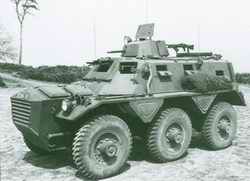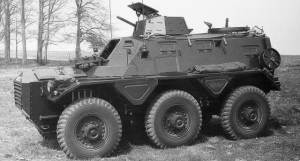| Designation: | SARACEN |
 |
|---|---|---|
| Manufacturer: | ALVIS PLC | |
| Product type: | Armoured Vehicles | |
| Name: | Infantry fighting vehicle |
Shortly after the end of the Second World War, the Fighting Vehicles Research and Development Establishment at Chertsey, which no longer exists, began the design of the FV600 series of 6 × 6 armoured fighting vehicles, to meet the operational requirements of the British Army. The first three models in this series were the FV601 Saladin armoured car, the FV602 command vehicle (which was cancelled in 1949 although the FV604 later took over its original role) and the FV603 Saracen APC. Owing to the situation in Malaya in the late 1940s, development of the FV603 was given precedence over the FV601 Saladin armoured car.
Design parent for the FV600 series was Alvis Limited of Coventry, which completed the first prototype of the Saracen in 1952 and first production vehicles in December the same year. The first Mk 1s were powered by a Rolls-Royce B80 Mk 3A petrol engine which had BSF threads but later production Mk 1s were powered by a B80 Mk 6A petrol engine and had UNF threads. Early production vehicles had a slightly different turret; the rear of the turret opened either side rather than folding down horizontally as on later turrets.
Throughout the 1950s and early 1960s the Saracen was the standard APC of the British Army and was replaced from 1963 by the FV432 tracked APC. Production at Coventry continued for export until 1972. Production of the Saracen APC amounted to 1,838 vehicles. Saracen APCs were widely used by the British Army in Northern Ireland in the IS role but these have now been withdrawn.
The Saracen was last used in the British Army by the Saracen Troop of 28 Squadron, the Queen's Own Gurkha Transport Regiment based in Hong Kong. This unit was disbanded early in 1993 leaving no Saracens in operational use with the British Army. All British Army Saracen vehicles have now been disposed of.
Production of the Saracen was undertaken at the Alvis facility in Coventry. With the merger of Alvis Vehicles and GKN Defence in late 1998, the Coventry facility was closed in mid-1999. In late 2004 Alvis Plc (which included Alvis Vickers) was taken over by BAE Systems and a new company was formed called BAE Systems Land Systems. This also includes the former RO Defence. The Saracen was built in the Alvis facility in Coventry, which has now closed down. Description
The hull of the Saracen armoured personnel carrier is made of all-welded steel armour construction with the engine at the front and the personnel compartment at the rear.
Air enters the engine compartment at the front of the vehicle through armoured louvres and is expelled through the four hatch covers over the engine compartment. Power is transmitted from the engine to the road wheels via a fluid coupling, five-speed pre-selective gearbox, transfer box with forward and reverse change, and differential transverse drive direct to each centre wheel hub through universally jointed shafts. Drive to the front and rear wheel hubs is by transmission shafts and bevel boxes. Each wheel hub houses an epicyclic train, which provides the final gear reduction to the wheels. Steering of the front two and centre wheels is by positive mechanical linkage, hydraulically assisted between the steering wheel and the road wheels. Hydraulic pressure for both steering and the foot brake is provided by an engine-driven hydraulic pump.
The suspension is of the double-wishbone type with torsion bars and sleeves. There are two telescopic double-acting hydraulic shock-absorbers fitted at each front and rear wheel station. The centre wheel stations each have a single telescopic double-acting hydraulic shock-absorber. The gearbox and the transfer box are under the floor of the crew compartment in the centre and the petrol fuel tank is under the floor of the crew compartment at the rear.
The driver sits at the front of the vehicle behind the engine compartment and has three No 17 day periscopes, one in front and one either side of his position. The periscopes are mounted in hatch covers. The hatch cover to the driver's front is folded forward onto the engine compartment for increased visibility and those either side fold upwards.
The section commander sits behind the driver on the left, with the radio operator in a similar position to his right. The eight infantrymen sit on individual seats, four down each side of the vehicle facing each other. They enter and leave the vehicle by two doors in the rear of the hull which open outwards and have a rectangular firing port that folds downwards on the outside. There are three similar firing ports in each side of the hull and a hull escape hatch over the second axle on each side. It should be noted that none of these firing ports are provided with an associated vision device.
The turret, which is similar to that fitted to the Ferret scout car Mk 2/3, has a basket-type seat and is mounted in the forward part of the roof. The rear part of the turret roof folds forwards and can be locked horizontal if required, while the turret rear folds downwards on the outside to form a seat for the gunner. The turret is armed with a 7.62 mm (0.30) Browning machine gun which has an elevation of +45° and a depression of -12°, except over the rear of the vehicle and is fitted with a No 3 Mk 1 day periscopic sight, which is mounted in the forward part of the turret roof.
At the rear of the roof is a ring mount which is normally fitted with a 7.62 mm Bren LMG or sometimes a 7.62 mm (0.30) Browning machine gun. Three electrically operated 66 mm smoke grenade dischargers mounted on each mudguard at the front of the vehicle launch smoke grenades to the front of the vehicle.
The Saracen APC is not fitted with an NBC system or any night vision equipment, although the latter could be fitted if required. A fresh air ventilation system is standard on all vehicles and pipes air from the outside (via two dome-shaped ventilators on the right side of the hull) to ducts running down each side of the personnel compartment. The Saracen has no amphibious capability, although a deep fording kit was developed for the vehicle. Variants
This was designed specifically for operations in the Middle East. On the basic model air is drawn in through the louvres at the front of the engine compartment and expelled through the four hatch covers over the top. On the reverse-flow cooling model air is drawn in through raised louvres at the back of the engine compartment, passed forward over the engine by the fans, the blades of which have been reversed, and then expelled through the radiators and front louvres. To prevent air rushing into the radiator and impeding passage of air through it in the opposite direction, a cowl was mounted over the front of the vehicle.
Some of the Saracens delivered to Kuwait in the 1960s were supplied with an open roof and a reverse-flow cooling system. None of these remain in service.
The FV604 is essentially the FV603 APC modified for use as a command vehicle.
The inside has been fitted with mapboards and modified to accommodate a crew of six: three staff officers, two radio operators and a driver. Externally, stowage baskets have been fitted as well as an auxiliary charging plant and additional batteries to power the communications equipment installed. To increase the working area for the command staff, a tent can be erected at the rear of the FV604.
The full designation of the FV610 is Armoured Carrier 6 × 6 Command GPO/CPO FV610(A). It has a crew of six, which normally consists of three staff officers, two radio operators and a driver. Its main difference from the FV604 is a wider and higher hull as it is anticipated that it will be used in the static role for longer periods than the FV604. Equipment fitted to the FV610 includes additional mapboards, communications equipment, an auxiliary charging plant and batteries.
This has the same hull as the FV610 and can carry 10 seated patients, three stretcher and two seated patients, or two stretcher and six seated patients, in addition to the crew of two, which consists of the driver and the medical orderly.
In 1991, it was announced that A F Budge Limited and the then Alvis had developed a conversion package for the Saracen 6 × 6 APC with the backing and assistance of Perkins Engines Company. The conversion involved the replacement of the existing petrol engine with a Perkins Engines Company Phaser 180 MTi diesel developing 180 hp. Further modifications include enhanced driveline components, an improved braking system, a new cooling pack and a modern electrical system.
This conversion package offers the advantages of improved fuel efficiency, improved reliability, increased operational range and a reduced fire risk.
In early 1994, the now BAE Systems Land Systems was awarded an initial contract worth USD10 million for the supply of AFV upgrade kits from an undisclosed country in Asia, believed to be Indonesia.
The vehicles concerned were the 76 mm Alvis Saladin (6 × 6) armoured car, the Alvis Saracen (6 × 6) APC and the Daimler Ferret (4 × 4) scout car.
Key parts of the upgrade are understood to include the replacement of the original petrol engine by a more fuel-efficient diesel engine.
This upgrade programme for Indonesia has now been completed and there have been no additional exports of this upgrade package.
The South African National Defence Force has placed its entire fleet of 250 Saracen APCs up for sale. All of these vehicles were refurbished during 1985 to 1988 and during this time underwent modifications to improve their RAM-D characteristics. Since then they have been placed in War Reserve.
|
||||||||||||||||||||||||||||||||||||||||||||||||||||
|
|||||||||
|
|||||||||||||||||||||||||||||||||
 |
 |








